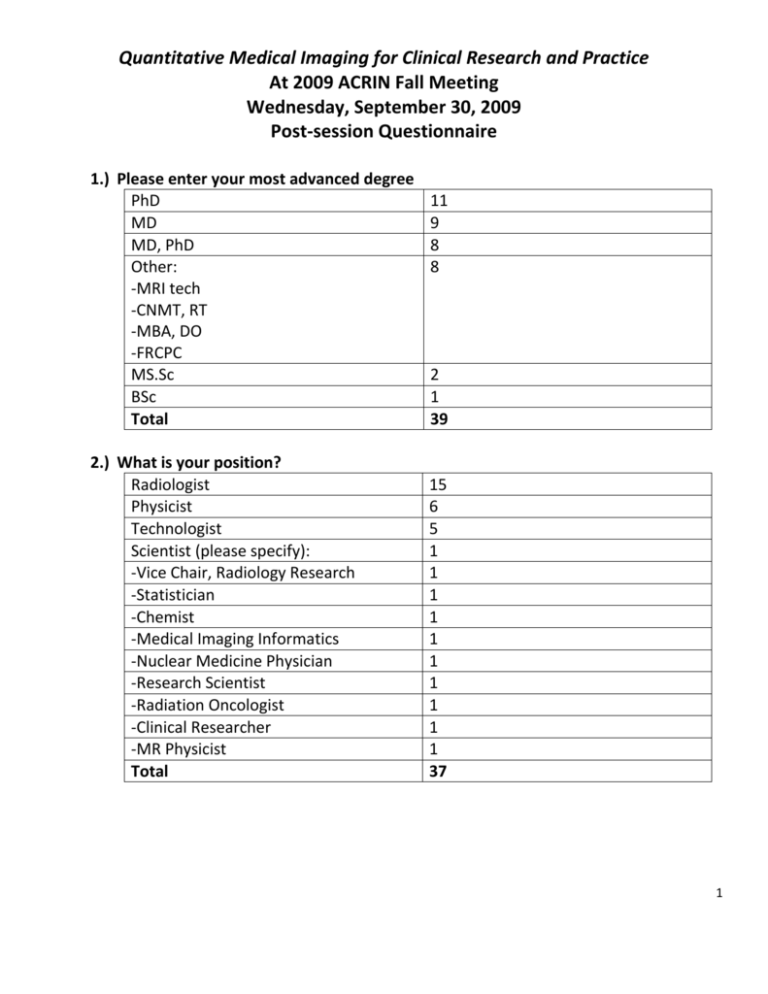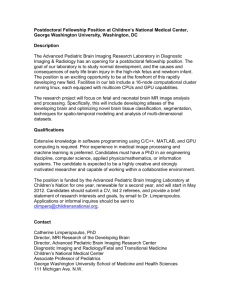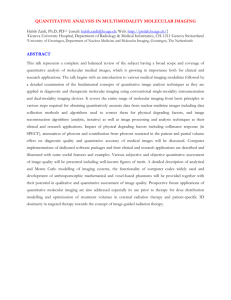Acrinfeedback - National Alliance for Medical Image Computing
advertisement

Quantitative Medical Imaging for Clinical Research and Practice At 2009 ACRIN Fall Meeting Wednesday, September 30, 2009 Post-session Questionnaire 1.) Please enter your most advanced degree PhD MD MD, PhD Other: -MRI tech -CNMT, RT -MBA, DO -FRCPC MS.Sc BSc Total 2.) What is your position? Radiologist Physicist Technologist Scientist (please specify): -Vice Chair, Radiology Research -Statistician -Chemist -Medical Imaging Informatics -Nuclear Medicine Physician -Research Scientist -Radiation Oncologist -Clinical Researcher -MR Physicist Total 11 9 8 8 2 1 39 15 6 5 1 1 1 1 1 1 1 1 1 1 37 1 3.) What computer system are you using? PC MAC, PC MAC MAC, PC, LINUX LINUX Total 21 6 5 5 1 38 WORKSHOP What did you hope to learn during this training session? Interested in developing a training program in quantitative imaging for radiology residents and junior faculty. Summary of state of the art Current trends Update on image strategies for trials Basic knowledge about imaging modalities (kind of) Issues and requirements for standardization of medical imaging Networking opportunity, informal dialog Basis of registration Overview, link to other information Challenges/standardization for acquisition; multi-vendor differences in image reconstruction and their impact on analysis; differences in analytical software (C.O.T.S. solutions); a great start-good discussion on many levels To see how quantitative biomarkers are used across all modalities Overview of image quantitation Update; current approaches Resources and initiatives currently existing on standardization Current issues in quantitative imaging Discussion of imaging issues in clinical trials Standardization Advances in imaging research and biomarkers, and if possible, photodiagnostic methods No comment Were your expectations met? Yes 2 What did you hope to learn during this training session? (Contd.) Expected to learn more about how the methods are actually used Acquiring quantitative information as well as effective ways to record and database Too basic, needs more depth No comment How to become involved in ACRIN? Were your expectations met? No Not sure what to expect. 4.) Please rate the speed at which the material was presented Just right 31 Too Slow 8 Too fast 0 Total 39 5.) Please rate the content of the lectures Just right 26 (1-assuming that pace for RSNA for physicians wanting a summary) Not enough information 11(1-very Harvard/Hopkins centered) Too detailed 2 Other 1-a little too basic Total 40 3 6.) Any suggestions for how we could improve our training program? For the clinically trained radiology resident/radiologist it would be very helpful to highlight how the goals of QI differ from current diagnostic imaging. Exampletailored protocols vs. standardized protocols, diagnostic accuracy vs. biomarker validation. Major roadblocks of QI; examples of successful biomarkers (other than imaging) in clinical trials More information on modalities best for specific disease indications and therapeutic agents More detail/quantitative analysis Focus on level of the audience, increase the number of case examples A bit broad still I thought the topics were treated too superficially Good initiative but it should be improved which might happen with more practice. A good review of different challenges/interests in imaging Links to slides, handouts, white papers to allow for self-paced learning Better teaching program, better slides The presentations could be improved by integrating visual examples throughout the talks Increase the number of case examples More examples/images A booklet/access to slide sets would be beneficial prior to presentations Provide copy of slides 7.) What topics would you be interested in for the future training sessions? What about teaching the reality? The new techniques are great to learn, but until these mature and become available to daily practice or trials, we still need more practical means, e.g. like for community centers!! Enjoyed the alphabet soup explanation of groups involved-seems there is a lot of a duplicative effort. Add information for how researchers can get involved in studies and standardization efforts if the purpose is to educate so that they can get involved. Good presentation of the issues that need to be addressed-a bit overwhelming for the new imaging researcher. Maybe some suggestions on what to do now and which issues are most important to address. Great how you make the information available online, slides-thanks. I would use this for our hospital techs-with perhaps some specific examples-to show why “research” study protocols are different from “clinical” studies. Consensus on standardization 4 What topics would you be interested in for the future training sessions? (contd.) The information was really a survey; for those who already know it, it was superficial. For those who didn’t know it, it is either irrelevant or not deep enough to be useful. The effect of proprietary reconstruction kernels on imaging in CT. Future of fMRI vs. Volumetric CT vs. RECIST for biomarkers. Effect of distortions on machine algorithms. Person vs. Machine accuracy. Role of phantoms. Non unique definition of HU. Two energy CT machines- what is measurable? Molecular imaging and novel radiopharmaceuticals outcomes research. (This course) very well done and much appreciated. More advanced quantitative image processing and analysis More on QIN and QIBA; Medical imaging informatics infrastructure to support quantitative imaging research Better understanding of individual vendors’ approaches. Can manufacturers be included in the discussion? Is there a place for them? Review current trials and biomarker (isotopes, etc), GBM, breast, lung, etc. hypoxia, cell proliferation, anti-angiogenic biomarkers How one can get involved with the trials?; basics for new researchers Review of these issues in clinical trials Diverse topics but you should be more specific (e.g. overview of the currently achieved standards and challenges) More data on reproducibility 5







